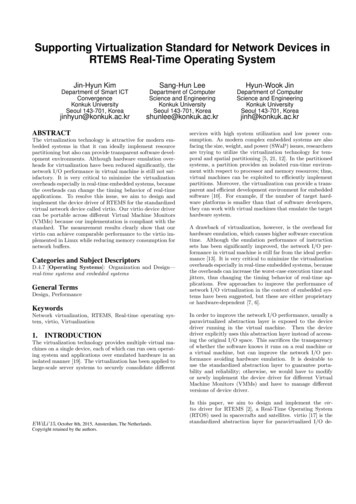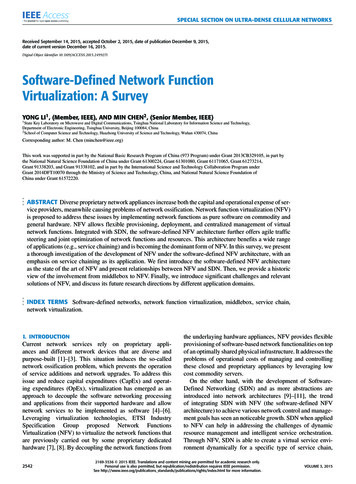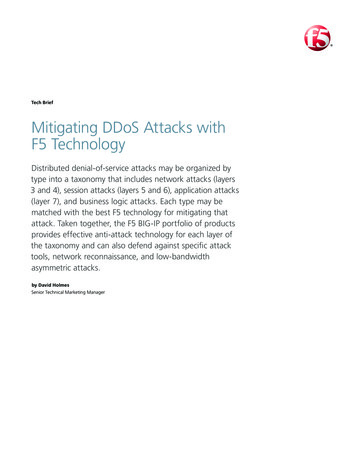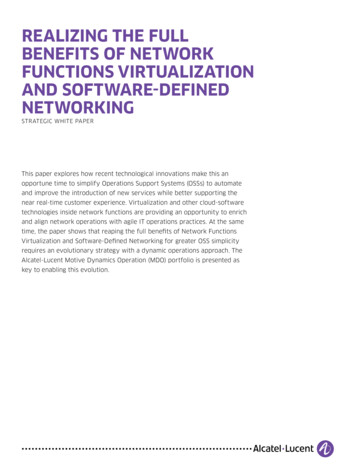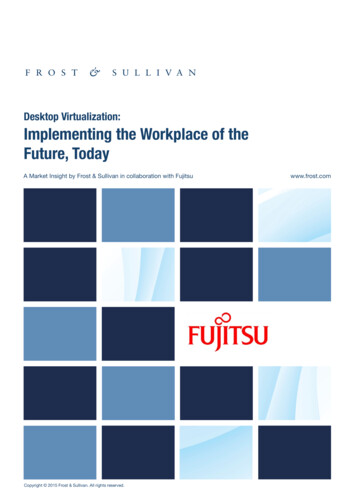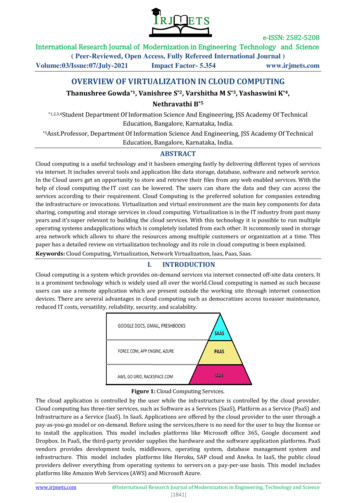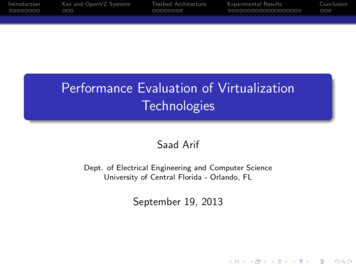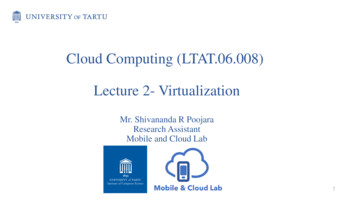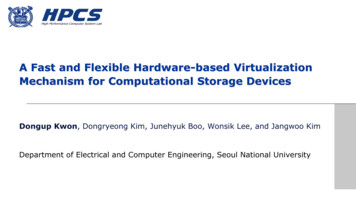
Transcription
Attacks against Network Functions Virtualization andSoftware-Defined Networking: State-of-the-artFrançois Reynaud, François-Xavier Aguessy, Olivier Bettan, Mathieu Bouet,Vania ConanTo cite this version:François Reynaud, François-Xavier Aguessy, Olivier Bettan, Mathieu Bouet, Vania Conan. Attacks against Network Functions Virtualization and Software-Defined Networking: State-of-the-art.Workshop on Security in Virtualized Networks (Sec-Virtnet 2016), workshop of 2nd IEEE Conference on Network Softwarization (NetSoft 2016), 2016., Jun 2016, Seoul, South Korea. pp.471-476, 10.1109/NETSOFT.2016.7502487 . hal-01393740 HAL Id: 1393740Submitted on 8 Nov 2016HAL is a multi-disciplinary open accessarchive for the deposit and dissemination of scientific research documents, whether they are published or not. The documents may come fromteaching and research institutions in France orabroad, or from public or private research centers.L’archive ouverte pluridisciplinaire HAL, estdestinée au dépôt et à la diffusion de documentsscientifiques de niveau recherche, publiés ou non,émanant des établissements d’enseignement et derecherche français ou étrangers, des laboratoirespublics ou privés.
Attacks against Network Functions Virtualizationand Software-Defined Networking: State-of-the-artFrançois Reynaud , François-Xavier Aguessy , Olivier Bettan , Mathieu Bouet and Vania Conan ThalesServicesCampus Polytechnique, 1 avenue Augustin Fresnel, 91767 Palaiseau cedex, FranceAbstract—Network Functions Virtualization (NFV) andSoftware-Defined Networking (SDN) are two emergingparadigms for networks. While being independent from eachother, they may be deployed together, which is likely to happenmore frequently in the future, as they bring many opportunitiesfor simpler, more flexible and energy-efficient networks.However, they also come with weaknesses that evil-minded userscould exploit to disrupt such architectures. In this paper, wesurvey attacks that have been or could be performed againstNFV and SDN, and propose practical countermeasures whenapplicable.I. I NTRODUCTIONNetwork operators use many different devices running proprietary software to provide specific network functions. As aconsequence, when they wish to provide new network services,they have to buy and configure new devices. This raisesseveral issues, such as the increasing equipment costs, thepower consumption increasing with each new device, a greatercomplexity that leads to higher operational expenses and misconfiguration proneness, and low dynamism and scalability.To address these issues, new network paradigms implementing the virtualization and softwarization of the network areemerging. For example, Network Functions Virtualization isa network architecture concept, standardized by the EuropeanTelecommunications Standards Institute (ETSI) [1], that consists in using standard hardware for hosting various, vendorindependent, network software components. Instead of havinga myriad of devices providing the Network Functions (NFs) asvendor-specific hardware and software, the NFs are virtualizedand consolidated onto standard hardware. The most obviousadvantage to this is the reduced equipment costs for networkoperators since they do not have to buy one device per NF.Software-Defined Networking is another paradigm, whoseprogress is led by the ONF [2], that consists in using acentralized programmable controller (control plane) to managean entire infrastructure (data plane) made of simple forwardingdevices. As a consequence, network operators need not toconfigure every device separately; they only have to programthe controller to reconfigure the network. This allows moreflexible and less error-prone network configuration.Although NFV and SDN can be deployed independently,they are complementary to each other, so it is obvious thatcombining both would augment individual benefits. Moreover,it is very likely that NFV will rely more and more onSDN, especially because of the inherent dynamicity of suchinfrastructure. In fact, these two paradigms are already startingto be deployed in real systems, either separately or together(e.g. Andromeda [3], or UNICA [4]).However, for NFV and SDN to achieve widespread adoptionby the industry, their security needs to be assessed, to beassured that they do not bring new security flaws that cannotbe dealt with effectively. In this paper, to measure the risksfaced by NFV and SDN, we adopt a practical point of viewand survey the attacks (i.e. any kind of malicious activitythat attempts to collect, disrupt, deny, degrade, or destroyinformation system resources or the information itself [5]) thatcould be performed against these two paradigms. For bothparadigms, we identify the components that are likely to betargeted by attackers, then attacks against these components.This paper is organized as follows: Section II surveys thethreats and attacks against NFV. Section III surveys the threatsand attacks against SDN. Section IV analyzes the root causesof the threats against NFV and SDN, and gives possiblecountermeasures. Finally, Section V concludes this work.II. N ETWORK F UNCTIONS V IRTUALIZATIONA. OverviewThe concept of NFV is very recent: it was born in October2012 from the collaboration of some of the world’s leadingTelecommunication Service Providers [6]. The ETSI wasselected to be the home of the Industry Specification Groupfor NFV (ETSI ISG NFV). Since then, a fair amount ofstandardization activities and collaborative NFV projects havebeen conducted, such as Open Platform for NFV (OPNFV)[7], or OpenMANO [8].NFV is expected to bring many benefits to network operators [9], like reduced equipment costs, reduced energyconsumption, shorter time to market, and increased serviceagility and possibility to optimize the network configurationand/or topology on the fly.The ETSI has defined an architectural framework for NFVin [1], whose a simplified version is presented in Figure 1.In short, it is composed of two main functional blocks:the Network Functions Virtualization Infrastructure (NFVI) onthe left side of the picture, and the NFV Management andOrchestration (NFV MANO) on the right side of the picture.The NFVI is the set of hardware and software componentswhich build up the environment in which the VirtualizedNetwork Functions (VNFs) are deployed [1], while the NFVMANO [10] is in charge of managing the lifecycle and
1Orchestrator4VNFVNFVNFVNFVNF geVirtualization er5StorageNFV InfrastructureManagement and OrchestrationFig. 1. NFV architecture and its critical assetschaining of the VNFs in order to provide the needed NetworkServices (composition of network functions and defined by itsfunctional and behavioural specification [11]).B. Targetable componentsWe identify the critical assets in the NFV architecture. Theyare represented on Figure 1.1) Virtualized Network Functions: VNFs could be eitherthe source or the target of an attack. Indeed, a VNF is asoftware component provided by a vendor independent of theinfrastructure provider. It can thus have software vulnerabilities or even be a malware, designed to perform attacks.2) Virtualization layer: Attackers could take advantage ofvulnerabilities present in hypervisors, for example, to escapefrom the virtual computing, network or storage to the host’sphysical compute, network or storage resources. This couldallow an attacker to undermine the confidentiality, integrityand/or availability of VNFs resources.3) Communications with and within NFV MANO: Attackers may try to eavesdrop or modify the traffic that transitsbetween the NFVI and the NFV MANO, as well as trafficwithin the NFV MANO.4) Orchestrator and/or VNF manager: Attackers mayattempt to exploit these two components to disrupt the lifecycle management of the Network Services (purpose of theOrchestrator) or of individual VNFs (main role of the VNFManager) [10].5) Virtualized Infrastructure Manager (VIM): The VIMis responsible for the management of the NFVI resources usedby the VNFs (compute, network and storage), and attackingit could for example allow Denial of Service (DoS) or datatheft, bypassing hypervisor isolation.C. AttacksAlthough some work was done to improve the securityof NFV environments (e.g. CloudBand [12] or integration ofpolicy enforcement [13]), most of the efforts to develop NFVfocused on management and orchestration (e.g. OpenMANO[8] or T-NOVA [14]).The ETSI identifies in [15] the threat surface of NFV asbeing the union of the threats to generic virtualization andgeneric networking. NFV being an implementation of Cloudcomputing for networking, we surveyed attacks that have beenperformed against Cloud computing systems and hypervisorsand analyzed the impact of such attacks on NFV. Potentialareas of concerns for NFV are also identified in [15], andsome of them are related to the attacks we surveyed.These attacks can be categorized depending on the components previously listed:1) Virtualized Network Functions: Denial of Service(DoS) attacks are a serious threat to Cloud and NFV environments. There are several examples of DoS attacks on serviceshosted in the Cloud, like Bitbucket, a web-based hostingservice company hosted by Amazon that was victim of massiveDDoS (Distributed DoS) attacks, making it unavailable tomany developers [16]. The danger of DDoS is even greaterin the context of Cloud Computing or NFV because it couldalso affect untargeted services and tenants that are hosted onthe same physical host.VNFs are software components providing network functions, so they are likely to be vulnerable to software flaws:it could be possible to bypass firewall restrictions or to takeadvantage of a buffer overflow to execute arbitrary code. CVE2012-2663 for iptables and CVE-2006-5276 for Snort areexamples of such vulnerabilities and, albeit old, they give afirst insight on the kind of dangers that may threaten typicalNFs that are going to be deployed in NFV infrastructures.2) Virtualization layer: Several types of attacks can beperformed on the virtualization layer: Code execution on the physical host: Wojtczuk [17]presents several attacks against common hypervisors (QEMUKVM, Virtualbox, Xen) that allow code execution on the hostfrom a compromised or malicious Virtual Machine (VM).The first one allows the attacker to obtain code executionin Xen’s privileged paravirtualization domain by making Xenrun a VM with a filesystem corrupted in such a way that itcan trigger CVE-2007-5497.The second one allows code execution on the host by usinga use-after-free vulnerability in QEMU-KVM, triggered byrequesting a PCI unplug action on the virtual RTC, that wasnot hotplugged in.Finally, the third attack uses a buffer overflow related to theemulation of the e1000 router to gain execution of arbitrarycode.Return-oriented-programming-based attacks: Riddle andChang [18] introduce an attack on the Xen hypervisor thatallows the attacker to escalate their VMs to a privileged stateby using return-oriented-programming.In the context of NFV, these attacks could be used to reador modify the memory of, take control of, or deny resources toVNFs co-resident with a malicious VNF (possibly disruptingseveral Network Services), or even deploy more maliciousVNFs. Resource monopolization: Riddle and Chang [18] presenttwo attacks to steal resources from other VMs:Monopolization of CPU: If the VMs are running over a Xenhypervisor then it is possible either to use up to 98% of the
physical host’s CPU, hence denying the CPU to other VMs,or to determine whether 2 VMs are co-resident (which can bethe starting point of another attack), by taking advantage ofXen’s credit scheduler.I/O performance-based attacks: If the attacker knows thescheduling characteristics of the hypervisor, they can use thatinformation to overload I/O resources, resulting in slowingdown co-resident VMs (or VNFs). Data theft: Riddle and Chang [18] explain that if the targetVM is co-resident with the attackers’ malicious VM and isinfected with malware, then the attacker can use memory busor cache contention to stealthily steal data, e.g. cryptographickeys, from the target VM. VM monitoring evasion: Riddle and Chang [18] presentthe VM rollback attack: if the hypervisor is already compromised, then the attacker may execute a VM from an oldersnapshot without the VM owner knowing it, allowing themto bypass security systems. For example, while the attackeris brute forcing a password, when the VM raises a securityalert, the compromised hypervisor rolls back to the previoussnapshot, and the attacker can continue their attack.Wang et al. [19] present the hypervisor introspection technique: when passively monitoring VMs, the hypervisor needsto suspend the VM to get a consistent view of the hardwarestate. By determining the frequency at which the hypervisorpauses the VM for inspection, attackers can perform operationsbetween the monitoring checks. This allow them, for example,to stealthily exfiltrate data (e.g. network traffic, in the case ofNFV) or to maintain a back-door shell on the VM.4) Orchestrator and/or VNF manager: Usingephemeral storage to steal data (CVE-2013-7130): Thecreate images and backing method in libvirt driver inOpenStack Compute (Nova), when using KVM live blockmigration, does not properly create all expected files, whichallows attackers to obtain snapshot root disk contents of otherusers via ephemeral storage. In an NFV over OpenStackenvironment this could be used to steal cryptographic keysfrom other VNFs, thus enabling, for example, eavesdropping,data modification, or impersonation.5) Virtualized Infrastructure Manager: Privilegeescalation (CVE-2014-3790): Ruby vSphere Console(RVC) in VMware vCenter Server appliance (centralizedmanagement and operation, resource provisioning andperformance evaluation of VMs in a distributed virtual datacenter) allows remote authenticated users to execute arbitrarycommands as root by escaping from a chroot jail, thus gaininggreat control over the infrastructure domain managed by theVIM.Regarding the areas of concerns about NFV identified bythe ETSI in [15], among the attacks we just presented, (D)DoSattacks can be related to availability of management support infrastructure, secure crash, and performance isolation.Resource monopolization attacks and the vulnerability CVE2014-3790 can be related to performance isolation, and datatheft can be related to private keys within cloned images.III. S OFTWARE -D EFINED N ETWORKINGA. OverviewAlthough SDN has been getting more attention over the pastfew years, it originates from ideas that appeared and evolvedsince more than 20 years ago [20], such as active networkingin the early 90s, and separating control and data plane inthe early 2000s. These ideas did not meet adoption fromthe industry because they lacked the pragmatism that wouldallow real-world deployment; the ONF introduced OpenFlow,immediately deployable, as a compromise between fully programmable networks and real-world deployment, allowing theSDN movement to be both pragmatic and bold [20].According to the ONF, OpenFlow-based SDN is expectedto have a certain number of benefits [2], including: Centralized control of multi-vendor environments: no needto manage groups of devices from individual vendors anymore. Automation: SDN makes it possible to automate manymanagement tasks that are done manually today. Higher rate of innovation: possibility to program orreprogram the network in real time. Increased network reliability and security: Reduced risk ofnetwork failures due to configuration or policy inconsistencies. More granular network control: OpenFlow’s flow-basedcontrol allows to apply policies at a very granular level.As shown in Figure 2, the architecture of SDN consists of3 layers:The application layer: the end-user applications that consume the SDN communication services.The control layer: the consolidated control functionalitythat supervises the network forwarding behavior through anopen interface.The infrastructure layer: the network elements and devices that provide packet switching and forwarding.These layers interact with each other through 2 interfaces:the Northbound Interface (NBI) between the application layerand the control layer, and the Control to Data-Plane Interface(CDPI) between the control layer and the infrastructure layer[21]. The NBI allows SDN applications to express theirnetwork behavior and requirements, and the CDPI providesprogrammatic control of all forwarding operations, capabilitiesadvertisement, statistics reporting and event notification [21].Although SDN comes with promising benefits, it also raisesnew security concerns, and Kreutz et al. [22] have identifiedseven threat vectors in SDNs. In this paper however, we choseanother point of view and decided to focus on the SDNspecific components that are the most likely to be attacked,illustrated in Figure 3:1) SDN switches: The traffic flows transit through theswitches, making them interesting targets for an attacker.2) Communications between control plane and dataplane: Switches are totally dependent on the controllers, socommunications between control plane and data plane alsoare interesting targets, maybe even more than the switchesthemselves.3) Controllers: Controllers bear all the intelligence of thenetwork, making them the most valuable target to attack.
ApplicationLayerSDN application SDN application SDN Network ServiceNetwork ServiceNetwork ServiceNetwork ServiceControl Data Plane rkdeviceNetworkdeviceNetworkdeviceFig. 2. Software-Defined Networking plicationControl tionData planeFig. 3. Targetable SDN componentsB. AttacksSeveral attacks have been performed against SoftwareDefined Networks, each targeting one or more components.1) Switches: Shin and Gu [23] show that a Denial of Service(DoS) attack against a remote SDN network could significantlydecrease its performance without requiring a large bandwidthor high performance devices.Romão et al. [24] perform a DoS on various switches byinserting permanent flows into them, either inserting the flowsdirectly by the controller or by sending a huge amount ofICMP requests to different IP addresses. The authors alsotry the debug mode, enabled by default on some switchimplementations, e.g. OpenWrt/Pantou, that basically providestotal control on the switch.2) Communications between control plane and dataplane: Romão et al. [24] perform 3 different Man-in-theMiddle (MitM) attacks, with different objectives: Interrupt traffic between the switch and the controller. Thiswas done by ARP poisoning both the switch and the controller,and caused undesired communication between networks thatare supposed to be logically separated. Eavesdrop traffic between two hosts. This was done bymirroring the traffic between the hosts toward a third host. Stealthily modify the traffic between two hosts. This wasdone by interrupting traffic between the two target host, sothey send ARP requests to which the attacker responds withhis own MAC address, instead of simply sending ARP replies.3) Controllers: Hong et al. [25] present two topologypoisoning attacks unique to SDN that affect major SDNcontrollers such as Floodlight [26] and OpenDaylight [27].Host Location Hijacking: This attack exploits the HostTracking Service, the controller’s service that maintains aprofile for each host in the network, and updates it as thehost migrates to impersonate a specific web server and phishusers. To do so, the attacker retrieves the target’s identifierused by the controller to identify the host (in the present caseit is the MAC address), and can then inject fake packets in thename of the target host. As a result, users trying to access thegenuine Web server are directed to the malicious server.Link Fabrication: This attack consists in fabricating a linkin the network either by injecting fake LLDP packets, or in arelay fashion, i.e. without modifying the packets. This attackcan be a first step for other attacks such as DoS attack, bytaking advantage of the Spanning Tree algorithm used byOpenFlow controllers to incapacitate normal switch ports, orMitM attack by using the fact that once it detects that a newlink is up, the controller recomputes the shortest route.Shin et al. [28] focus on malicious applications directlyattacking the controller. They tested 4 SDN controllers: Floodlight, OpenDaylight, POX and Beacon [29]. Their attacksaim at crashing the controller, or confuse other control layerapplications, which they achieved with minimal effort. In thecase of Floodlight, for instance, they crashed the controllersimply by calling sys.exit() function or continuously allocatingmemory, leading to an out of memory crash. They also trickeda monitoring application into "thinking" there was only onelink in the network by deleting a network link in an internalFloodlight data structure (Link Deletion).There also are several CVE Identifiers related to controllers:The REST layer on HP SDN VAN Controller devices allowsremote attackers to cause a Denial of Service via networktraffic to the REST port (CVE-2015-2122).The Netconf service in OpenDaylight 1.0 allows remoteattackers to read arbitrary files via an XML eXternal Entity(XXE) declaration in conjunction with an entity reference inan XML-RPC message, related to an XXE issue (CVE-20145035). This could allow attackers to gain information aboutthe configuration of OpenDaylight or the Operating Systemon which it is running (e.g. installed services), as a first stepfor another attack, for example.IV. ROOT CAUSE ANALYSIS OF ATTACKS ON NFV ANDSDN AND POSSIBLE COUNTERMEASURESA. Network Functions VirtualizationAs said in section II-C, NFV is an implementation of CloudComputing for networking, and is exposed to similar threats:Distributed Denial of Service: The problems enabling thiskind of attack are the fact that resources are not unlimited,and the fact it is hard to distinguish normal traffic fromattacking traffic. While there is not much that can be doneabout the resources, solutions have been proposed to defend
against DDoS, e.g. Joshi et al. [30] proposed Cloud TraceBack, a solution using a back-propagation neural networktrained to detect attack traffic. Once attack traffic can bedistinguished from normal traffic, it becomes possible todefend against (D)DoS attacks, by using techniques such asselective blackholing [31].Code execution on the host, privilege escalation, isolation breaking: There are many vulnerabilities in hypervisorswhose exploitation allows these. Between 2013 and 2015 (included), more than 50 CVEs concerning VMWare’s VSphere,Qemu, KVM, XEN, Hyper-V, LXC and Docker having aCVSS (Common Vulnerability Scoring System) score greaterthan 7 (out of 10) were published. The fact that so many CVEswith such high scores were published in 3 years is a sign thata lot of work has yet to be done regarding the security ofhypervisors, essential for the security of NFV.Some of these attacks exploit buffer overflows, which canbe countered with techniques such as ASLR or canaries.Side-channel attacks: In side-channel attacks, attackersinfer information in an indirect manner, e.g. measuring thefrequency at which a VM is paused. To defend against thistype of attack, the basic idea is either to eliminate or reduce theinformation released by the side channel (e.g. reduce electromagnetic emissions in case of TEMPEST [32] attacks), or tointroduce some kind of noise to the channel.B. Software-Defined NetworkingAs we have seen, Software-Defined Networks are exposedto 3 main types of attacks: Denial of Service, Man-in-theMiddle, and Network Visibility Poisoning (NVP). For each ofthese types of attacks, the vulnerabilities exploited may lie inone or more of the targetable components; e.g. a (D)DoS attackmay be at the forwarding layer level, saturating the storageresources of one or more switches, or it could be at the controllayer level, saturating the compute and storage resources of thecontroller. As there are several points of attack, it seems prettyreasonable to say that all these points need to be consideredwhen securing SDN-enabled networks.Denial of Service: At the forwarding plane level, each SDNswitch stores one ore more flow tables. The problem is that theflow table storage capacity of switches is finite, which makesit possible for switches to be saturated. As switches capacitycannot be increased at will, other mitigation solutions have tobe found. At the control plane level, beside the controller’slimited resources, the lack of application resource checkingand isolation from the controller is another reason why controllers are vulnerable to DoS attacks [28]. The main difficultywhen trying to defend against DoS attacks is that it is not easyto make the difference between normal traffic and attackingtraffic. Shu et al. [33] present several countermeasures that canbe used to mitigate the effects of DoS attacks, among others.For example: FlowVisor [34] allows SDN network operatorsto partition their network in slices; it rewrites rules it receivesfrom the controller so that these rules only affect the slice thenetwork is allowed to control. This can be used to prevent aDoS attack to affect the whole network.Virtual source Address Validation Edge [35] is a countermeasure against DoS attacks caused by IP spoofing.FloodGuard [36] is a protocol-independent framework thatuses proactive flow rule analyzer to detect traffic flows causedby DoS attacks, and packet migration to prevent the controllerfrom consuming too much computing resources.Man-in-the-Middle: Just like in traditional networks, MitMattacks are possible when there is no proper authenticationmechanism. As most vendors did not provide support forTLS in their switches, the configuration of TLS was declaredoptional in OpenFlow specification in versions after v1.0.But even without SSL/TLS, solutions exists. For example,FortNOX [37] enforces rules inserted by a security application,i.e. if a security application inserts a rule and another application tries to insert a new rule, FortNOX will prevent otherapplications to insert rules that conflict with the rules definedby the security applications. We however think that SSL/TLSshould be implemented to help counter MitM attacks.Network Visibility Poisoning: The feasibility of NVPattacks may come from several security issues such as thelack of authentication like in Host Location Hijacking [25]and Link Fabrication [25] attacks, or the fact that the controlleris not sufficiently protected from the Northbound applicationslike in the Link Deletion attack [28]. To address these issues,Rosemary [28] and TopoGuard [25] have been proposed.Rosemary is a SDN controller that rectifies, among otherissues, the lack of access control and authentication forthe applications responsible for the Link Deletion attack byemploying a sandbox approach (App Zone). TopoGuard usesTopology Update Checker to verify the legitimacy of a hostmigration, the integrity/origin of an LLDP packet and switchport property once detecting a topology update.C. Combining Network FunctionsSoftware-Defined NetworkingVirtualizationandThere is not a unique way to use NFV and SDN conjointly.The ETSI has recently published a report [38] on the usageof SDN in the NFV architectural framework that presentsseveral possibilities for integrating SDN in the NFV architectural framework. There are many combinations, dependingon where the SDN controllers, switches and applications arepositioned in the NFV architecture. These combinations canbe grouped in two main categories:SDN used in the tenant domain: the SDN controller isa VNF, instructing other VNFs for taking actions on thetraffic. In that case the SDN controller, and thus, the VNFs itcontrols, may be impacted by vulnerabilities of NFV, possiblydisrupting an entire Network Service.SDN used in the infrastructure domain: the SDN controlleris part of the NFVI. It supports the infrastructure network, forexample by setting up the required connectivity between NFVIPoints of Presence. Consequently, the vulnerabilities that affectthe SDN controller may impact the entire NFVI as well.The main use case for NFV and SDN to be used conjointlythat we identified is 5G (i.e. the convergence of both fixed andmobile accesses relying on programmable networks), where
multiple tenants share services instantiated as VNFs, providedby various vendors and coordinated using SDN. Although nonew vulnerabilities arise from the fact of combining NFV andSDN itself, a multi-tenancy context like that of 5G changes theconfidentiality, integrity and availability requirements, and theexploitability and impact of already existing vulnerabilities.So, combining NFV and SDN may have a non negligibleimpact on the security of the 5G infrastructure.V. C ONCLUSIONIn this paper, we surveyed attacks that may impact NetworkFunctions Virtualization and Software-Defined Networking inorder to have a concrete vision of the dangers that threatenthem. We are not aware of any attack that specifically targetedan NFV infrastructure, so we looked for CVE Identifiersand attacks related to Cloud computing and hypervisors andanalyzed the impact of such attacks on NFV. Indeed, thesecurity of both NFV and Cloud computing depend stronglyon that of hypervisors.What we found out is that, albeit promising, NFV andSDN have a non negligible number of weaknesses. We believethat, being the core elements of these two paradigms, thesecurity of SDN controllers, NFV MANO and hypervisorsrequire particular attention. This will be especially importantfor inf
For example, Network Functions Virtualization is a network architecture concept, standardized by the European Telecommunications Standards Institute (ETSI) [1], that con-sists in using standard hardware for hosting various, vendor-independent, network software components. Instead of having a myriad of devices providing the Network Functions (NFs) as vendor-specific hardware and software, the .

